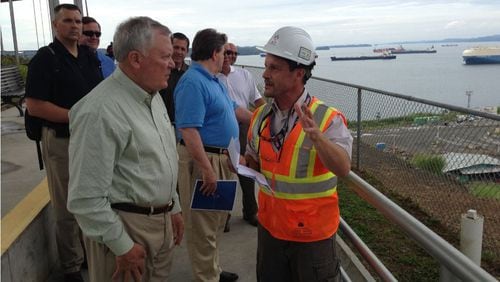The Atlanta Journal-Constitution is keeping close watch on developments in the Savannah port expansion project, which officials say is vital to the state and metro economy. For today’s story, AJC reporter Greg Bluestein traveled with Gov. Nathan Deal to Panama for a first-hand look at the Panama Canal expansion and its role in the Savannah project.
Colón, Panama - In a soggy abyss carved into Panama's craggy rockbed, a convoy of Georgia's top leaders snaked a path through a construction project that could transform international trade.
In about a year, the course they followed on Monday will likely be under water, at the bottom of a new channel that will float a class of gigantic cargo ships already plying the seas in search of ports deep enough to handle them.
But for now the Panama Canal expansion holds only tantalizing promise and daunting challenges for Georgia, which has been preparing for its effects since before Panamanian voters approved the project seven years ago.
The state is closer than ever to getting federal approval to begin dredging Savannah’s bustling port to accommodate the bigger freighters that will pass through the enlarged canal, but there’s no guarantee the feds will contribute their share of the $662 million project.
And even if the Savannah port is dredged, rival ports up and down the east coast also racing to carve deeper harbors in advance of the canal expansion. So Savannah will face more competition than ever from deeper ports from Florida to New Jersey.
On the line are political reputations, hundreds of millions of dollars of public money and Georgia’s position as what Gov. Nathan Deal calls the “gateway to Southeastern commerce.”
The governor led the delegation to Panama, he said, so he can “speak from a first-hand position” about a project that has consumed much of his first term. State ports officials went along to pitch Savannah to canal leaders who hold sway with shipping executives able to swing more traffic Georgia’s way.
Deal is preparing an intense new round of lobbying for federal funds for dredging at the same time he’s pushing Washington to allow the state to start using more than $230 million it’s already socked away for its share of the cost.
The race to exploit the canal’s expansion has raged for years. Deal suggested it’s entering the final lap.
“We stand a chance of losing a lot of what we already have because it is going to be more economical for shippers to put their cargo on larger vessels,” Deal said after a bumpy van trip through the rocky depths of Panama’s new set of Atlantic locks.
“This only accelerates the timeline for me to get the Savannah port deeper.”
‘Building it to last’
The Panama Canal opened almost a century ago after tens of thousands of workers forced a 48-mile swath through malarial jungle. The system of locks and lakes remains one of the most inspiring engineering projects in human history, a marvel that drastically cut shipping times between the hemispheres.
The canal’s first significant expansion since its 1914 opening is almost as ambitious. Approved by a national referendum in 2006, the $5.25 billion project expands and deepens the current channels and creates a wider new lane for shipping traffic.
Some 4,500 workers toil around-the-clock on one section of the expansion alone, working 12-hour shifts in hopes of opening the canal by the middle of 2015. Project manager Gerry Del Rio marvels at their progress.
“To this day, I still think how impressive this project is,” Del Rio said, waving to the dozen construction cranes dotting the skyline. “We’ve built the skeleton and now we have to work on the brain. And they key is building it to last.”
At a cost of roughly one-sixth of Panama’s gross domestic product, the expansion will double the canal’s capacity and ease a boat bottleneck that can tie up ships for a week.
Steel sliding gates so vast they make workers seem like specks stand ready to be installed behind a towering wall that prevents the waters of neighboring Gatun Lake from surging into the construction zone.
As Deal’s convoy plunged through the site, he put words to what others in his van were thinking.
“I am just hoping the plug sticks.”
Port of Atlanta?
About 1,600 miles away, Georgia is tying its largest public infrastructure project to the canal’s expansion.
The effort to dredge Savannah’s port from 42 feet to 47 feet — just enough to handle the new class of freighters expected to use the expanded canal — has weathered environmental challenges, lengthy bureaucratic reviews and political gamesmanship.
A vote next month could bring Congressional approval, but getting federal money allocated would still depend on future budget decisions.
Meantime, Deal’s administration plans to ask the White House to allow Georgia to unleash the $231 million state legislators have already set aside for dredging. Deal said a bipartisan lobbying barrage will also soon intensify to urge that the feds to pick up the other $400 million or so of the tab.
A quieter effort is underway to roll out the welcome mat for the “post-Panamax” ships, some able to carry almost three times more cargo than the freighters already chugging through Panama.
Georgia’s port authority, which organized the trip, has spent $760 million in the past decade to upgrade Savannah’s terminal with container handling equipment, rail facilities and IT systems to appeal to shipping firms and their retail customers.
The state and railroads have been shoring up the inland web of roads and rail lines connecting to the hubs of warehouses and distribution centers that offload the container crates to customers across the region. A long-awaited highway extension for trucks moving from the port to the interstates each day is moving forward.
Some 14 ships a week arrive at Savannah after passing through the Panama Canal, and even with the dredging the larger freighters that soon will ply the locks may still be restricted by the river’s shallowness. Some fear those ships could bypass Savannah for good if not for the dredging.
“We need to make sure these ships don’t get in a pattern of going up the East Coast while we’re getting Savannah ready,” Deal said after watching a massive freighter ply the Pacific locks. “Time is of the essence.”
State leaders argue the expansion’s fate is particularly important to metro Atlanta, where an estimated 100,000 jobs are directly tied to the distribution of goods that come through Georgia ports. Ports authority director Curtis Foltz even calls the Savannah terminal, “The Port of Atlanta.”
Part of the argument for federal funding is that the combination of the Savannah port and metro Atlanta’s warehouses and highways constitutes critical national infrastructure.
“If Savannah is the gateway to the Southeast,” Foltz said, “Georgia can be a logistics hub for the nation.”
Doubts, issues persist
Some caution the Savannah project isn’t worth the money and question projected job and economic benefits.
Shifting global cargo patterns, competition from the Suez Canal and warmer weather patterns that could open new ocean routes could reduce demand, they say. Others note that rivals including Charleston, Miami, Norfolk and New Jersey either plan or already boast deeper harbors than Savannah even after the dredging.
“They really should be even deeper than the planned 47 feet, by at least a few feet,” said Jon T. Gabrielsen, an Atlanta-based logistics consultant. He also noted that even the “newly expanded canal already is too small for the largest ships being built today.”
An equally daunting task is bolstering the rail and road network serving goods unloaded at Savannah. Last year’s failure of a one-percent sales tax to fund transportation projects across most of Georgia put many upgrades aimed at port traffic on the back-burner. A backup plan has yet to emerge.
Still, Georgia lawmakers are wary of being caught flat-footed. Lawmakers are considering pumping an additional $30 million toward the dredging next year. And Vice President Joe Biden’s “hell or high water” endorsement of the Savannah deepening last week gave Atlanta Mayor Kasim Reed and other boosters reason to believe their effort would pay off.
“Trust me,” said Reed, who has pushed hard for the project, “the juice is worth the squeeze.”
About this story
The Atlanta Journal-Constitution is keeping close watch on developments in the Savannah port expansion project, which officials say is vital to the state and metro economy. For today’s story, AJC reporter Greg Bluestein traveled with Gov. Nathan Deal to Panama for a first-hand look at the Panama Canal expansion and its role in the Savannah project.
About the Author







